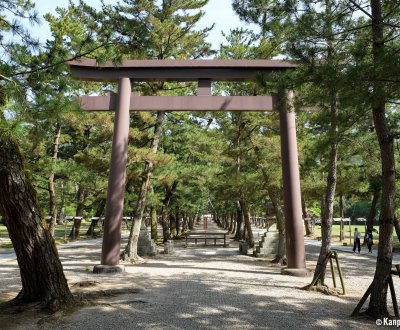The Main Shinto Gods
Kami Japanese Deities
The Shinto gods are named kami in Japanese and are part of the Shinto cult and of the Japan’s mythical foundation, its territory, and its civilization. Related to natural elements or to important realms of the daily life, these countless god-spirits are worshipped in shrines.
The official birth of the Shinto cult in Japan is hard to date exactly. It is usually considered that its development was intimately intertwined with the birth of the Japanese civilization, during the prehistorical Jomon period between 13,000 and 400 B.C. approximately.
Shintoism is an animist and polytheistic religion and has no official founder or sacred text. Two major writings do exist however, regarded as the oldest known texts on the subject:
- 古事記 Kojiki dated in 712, named in English "Records of Ancient Matters"; and,
- 日本書紀 Nihon Shoki compiled in 720, whose title is translated as "The Chronicles of Japan".
These collections tell the history of Japan and its majors founding myths, as well as the chronology of the Shinto gods called 神 kami. They also put into writing practices that are still performed today, the rituals and ceremonies associated to the cult of these divine spirits.
An infinity of gods
The word "Shinto", 神道in Japanese, means the "way of the gods" and defines the existence of a myriad of gods. The quasi-infinite number of Shinto deities in Japan is sometimes estimated to 8 million. This number includes natural phenomenon, such as waterfalls or rocks with a specific shape, as well as primary elements such as the sun, the wind, and the earth.
Actually, the concept of kami is broader than that of a simple god. A famous Japanese scholar, Motoori Norinaga (1730 - 1801), gave the following definition:
"[…] any being whatsoever which possesses some eminent quality out of the ordinary, and is awe-inspiring, is called kami."
From: Robert S. Gall, "Kami and Daimōn: A Cross-Cultural Reflection on What Is Divine", Philosophy East and West, Vol. 49, No. 1 (Jan. 1999), p. 63, University of Hawai'i Press
Outside Japan, acquaintance with kami is often made through Studio Ghibli and Hayao Miyazaki’s animated movies where they are introduced with great poetry.
These spiritual entities, like humans, have moods and can make good deeds as much as bad ones. The good and the evil are not opposed, and a deity can be both throughout its existence. A mortal who has accomplished great deeds, such as war generals or influential thinkers can be deified and worshiped.
The Shinto shrines are usually called jinja and are places of worship for the Japanese and a residence to rest for the divine spirits. They can be found anywhere, nestled at a corner of a street in a city or sheltered under a whole forest. Most of the sites are home to several kami and there is a sanctuary hierarchy in Japan, with the 2 most important and sacred being Ise and Izumo.
Every year, shrines stage festive celebrations called matsuri. One of the highlights of these festivals is the parade of kami in their mikoshi portable shrines in the surrounding streets, to bless the neighborhood and its inhabitants.
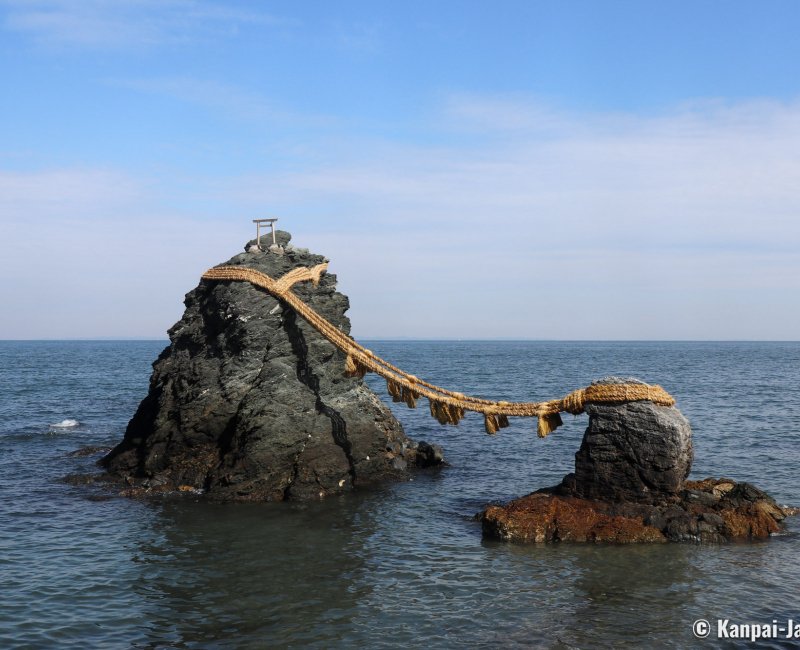
The main Japanese kami
To show their respect for the gods and their actions, the Japanese use the following honorific suffixes:
- 様 orさま "-sama";
- 命 or 尊 "-no Mikoto";
- 大神 for "Okami" which means "great god" and is only used for the most important kami.
Note that each Shinto deity’s names can often be written with different kanji. We made a non-exhaustive short list of the main Japanese kami, that are frequently encountered when visiting shrines in Japan or through the pop culture, especially video games and manga.
👫 Izanagi and Izanami (伊邪那岐 / 伊邪那美)
Respectively the primal god and goddess, Izanagi and Izanami represent the couple founder of Japan and are also twins.
They stirred the ocean with a celestial spear from the floating bridge in the sky. The drops of salt that stuck to the spear formed the archipelago’s first piece of land and is located nowadays in Awaji Island in the Kansai area. They settled on the island and decided to marry, giving birth to the other islands of Japan as well as to countless kami.
When Izanami gave birth to the fire 🔥 god named Kagutsuchi, she suffered lethal burns. Izanagi thus endeavored to bring her back from the realm of the dead, but he was unsuccessful and had to flee with a horde of demons chasing after him.
After escaping Hell, he closed its access and went to purify himself at a spring 🌸, where his daughter Amaterasu, among others, was born. The place is said to be the Isuzu-gawa river, that crosses Ise Jingu Grand Shrine’s grounds in Mie prefecture. The purification gestures of cleaning hands and mouth with water thus became a custom and mandatory for anyone visiting a shrine.
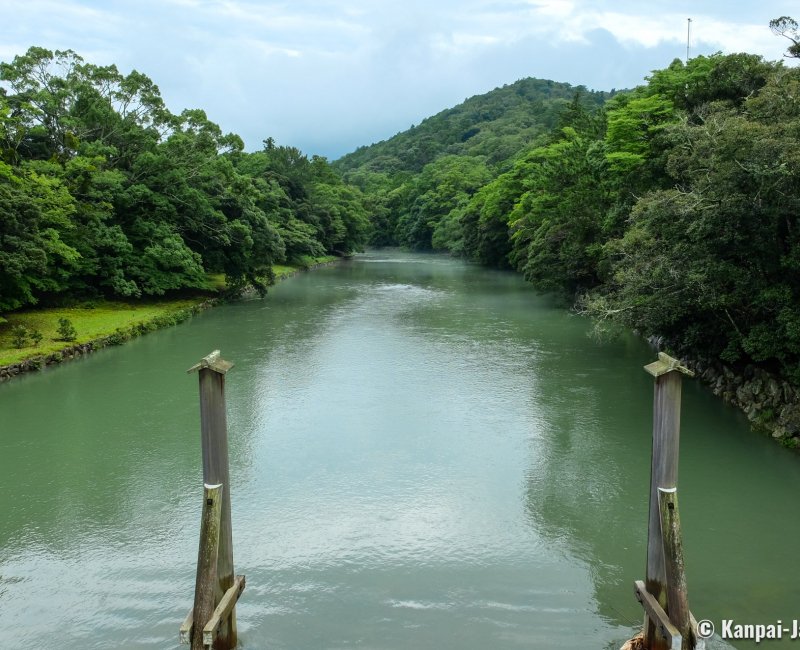
☀️ Amaterasu (天照)
The sun goddess Amaterasu was born from her father’s left eye when he was purifying in the river in Ise. One of her brothers is Tsukuyomi (or Tsukiyomi) born from Inazagi’s right eye and deemed god of the moon and the night. Amaterasu is the most venerated deity in the Shinto cult, and the Japanese flag 🇯🇵 Hinomaru, symbolizing the sun in a red circle, is a direct reference to her.
A famous mythical story tells that infuriated by Susanoo, another of her brothers, she retreated in a cave, consequently depriving Earth of sunlight for several years. To convince her of going out, the other gods imagined a trick with a mirror to make her think another sun was born. When she peaked outside the cave, her own beams were reflected, and she decided to leave her hideout.
Later after this episode, Amaterasu sent one of her grandsons named Ninigi on Earth to rule the country. He descended from the sky with 3 relics his grandmother offered him:
- The mirror Yata no Kagami, the one used to make her leave her concealment;
- The sword Kusanagi no Tsurugi; and,
- The beads necklace Yasakani no Magatama.
These 3 objects, the most sacred of Shintoism, are respectively preserved at Ise Grand Shrine, Atsuta-jingu shrine in Nagoya and in Tokyo Imperial Palace.
🌪 Susanoo (素戔嗚)
Amaterasu’s younger brother, Susanoo was born from his father Izanagi’s nose when he purified himself in the river in Ise. The god of storms and destructive nature, he is characterized by being easily angered while being sometimes able of positive acts.
Susanoo first ruled the world along his sister. However, he angered her so many times that she retired in a cave.
Following this vexatious episode Susanoo was driven away from the celestial gods’ world and came on Earth where he arrived in Izumo area. He saved the young princess Kushinada-hime from the 8-headed dragon named Yamata no Orochi and married her. He retrieved the famous sword Kusanagi no Tsurugi from the dragon’s tail and offered it afterward to Amaterasu as a reconciliation gift.
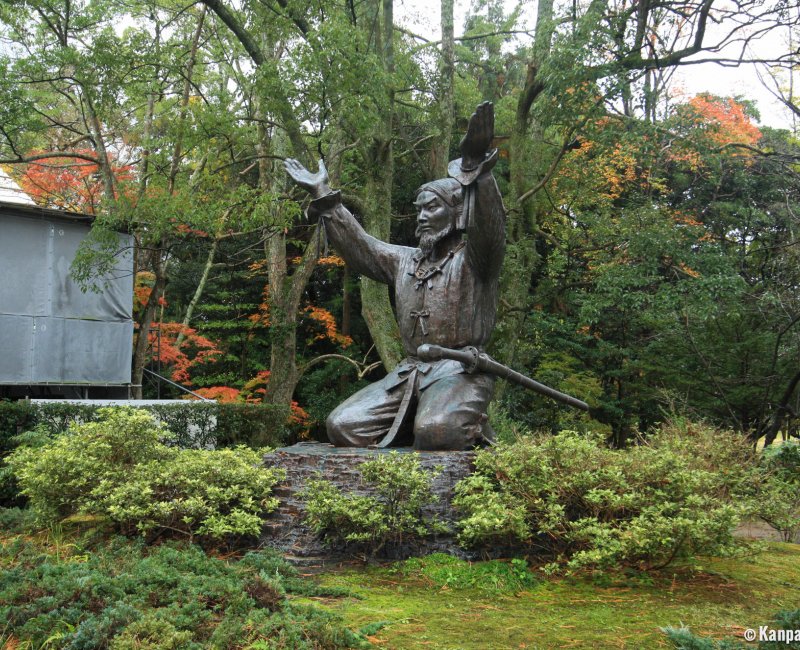
🌾 Okuninushi (大国主)
A descendant of Susanoo, Okuninushi is the tutelary kami of Izumo Taisha Grand Shrine. A benevolent and generous spirit, whose name means "ruler of the great land", he is notably worshiped as the god of agriculture and medicine. A specific deity of the Izumo area, Okuninushi was later incorporated into the national mythology and to the pantheon of the most important Shinto gods.
According to the Kojiki, he went through many ordeals before being able to rule over the Izumo region. He was in line with his 80 brothers to wed princess Yagami-hime and won her hand by helping Inaba the rabbit-god. Extremely jealous, his brothers tried to kill him twice, but his mother resuscitated him and sent him seek refuge in the hells of Ne no Kuni where Susanoo reigned.
There, he fell in love with Suseri-hime, Susanoo’s daughter and had to overcome the many hurdles imagined by the god of storms. He eventually came back to Earth with his ancestor’s blessing, vanquished his brothers and could reign in peace over Izumo. Later he granted his power to Ninigi, sent by Amaterasu.
In syncretic Buddhism, Okuninushi is sometimes associated to Daikokuten, also a god of agriculture and one of the 7 Lucky Gods of Japan.
🦊 Inari (稲荷)
Initially the god of good harvests in a country where rice cultivation is ubiquitous, today Inari is worshipped as the god of successful business. He is one of the most popular and most represented kami of Japan.
In most of the religious grounds, one can see statues of the kitsune fox, the sacred animal messenger of Inari. It is often holding a key in its mouth, that is said to open the doors of a giant cereal granary storing all the harvests of the universe. It is often dressed with a red bib, in the same way as the Jizo Bosatsu statues of Japanese Buddhism.
His cult dates to the early 8th century and is said to have been introduced by the Hata clan, a family of Korean immigrants, who made of a countryside kami its tutelary god and settled in Fushimi in the south of Kyoto. The name "Inari" is said to derived from the word "Inanari" that means "rice growth". Its main shrine is the famous and majestic Fushimi Inari Taisha.
In the syncretistic concept, Inari is also associated with female deities and protectors of Buddhism named Dakini or Mahakala, or in other words Daikokuten.
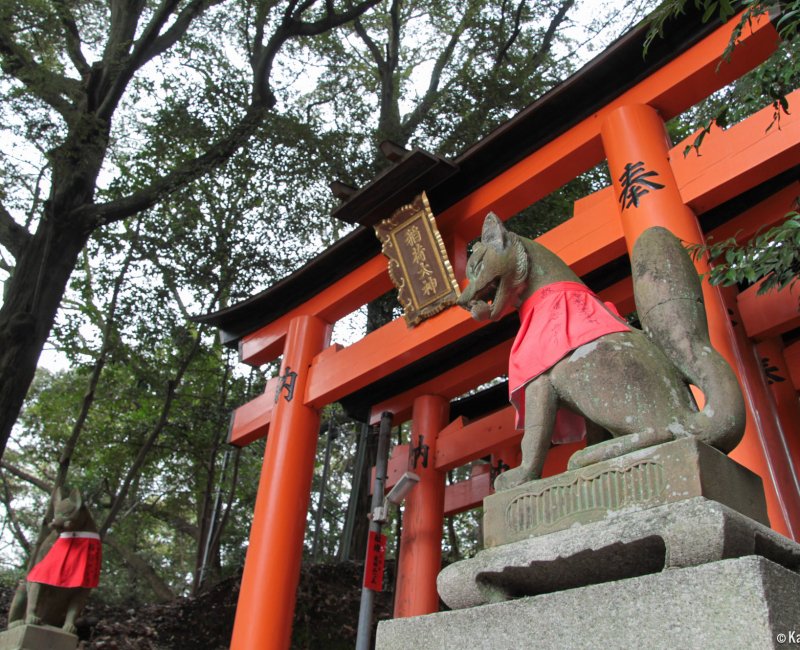
⚔️ Hachiman (八幡神)
A respected god of war since the feudal period, Hachiman is mainly worshiped by the warrior class encompassing the samurai and their lords. More than 40,000 Hachiman-gu shrines are dedicated to his cult and built throughout the country. The kami is also merged with the historical emperor Ojin (200 - 310).
Born in the Buzen province (today’s Fukuoka prefecture on Kyushu Island), this deity was first associated with the activity of bronze mining. The spiritual site of Usa-jingu in Oita prefecture, founded during the Nara period (710 - 794), is thus the main of Japan’s Hachiman-gu shrines.
In 859, the Iwashimizu enclosure, set between the cities of Kyoto and Osaka, became a Hachiman-gu shrine, very influential within the imperial household that was then established in Heian-kyo (later Kyoto). Nowadays, it is still considered as the second place of worship linked to the imperial ancestors and the most important after Ise.
Hachiman is also known as the Minamoto clan’s protective kami. The skillful warrior Minamoto no Yoshiie (1039 - 1106) is said to have had his coming-of-age ceremony in Iwashimizu Hachiman-gu shrine, which definitely connected the god to the art of war. Later, Minamoto no Yoritomo (1147 - 1199) who ascended to power as the first shogun of the Kamakura period (1185 - 1333) ordered the enlargement of Tsurugaoka Hachiman-gu shrine to thank the god for his help in the war against the Taira clan.
⚡️ Kaminari and 💨 Fujin (雷神 / 風神)
Syncretistic deities both existing in the Shinto cult and Buddhism, Kaminari and Fujin are respectively god of thunder and god of wind.
Kaminari is mainly known under his Buddhist name: Raijin or sometimes Raiden. He is pictured surrounded by a halo of 8 drums that symbolize the sound of thunder and can ward off evil spirits. Usually drawn with an aggressive look, he then resembles a warrior figure and is a guardian deity protecting the entrance of temples and shrines.
The god of wind, also named Futen, originates from the Hinduist deity Vāyu and is holding on his shoulder a large bag or piece of fabric containing the wind. Fujin is rarely worshipped alone, and most of the times he is pictured along with Raijin, especially under the great Kaminari-mon of Senso-ji temple in Asakusa in Tokyo.
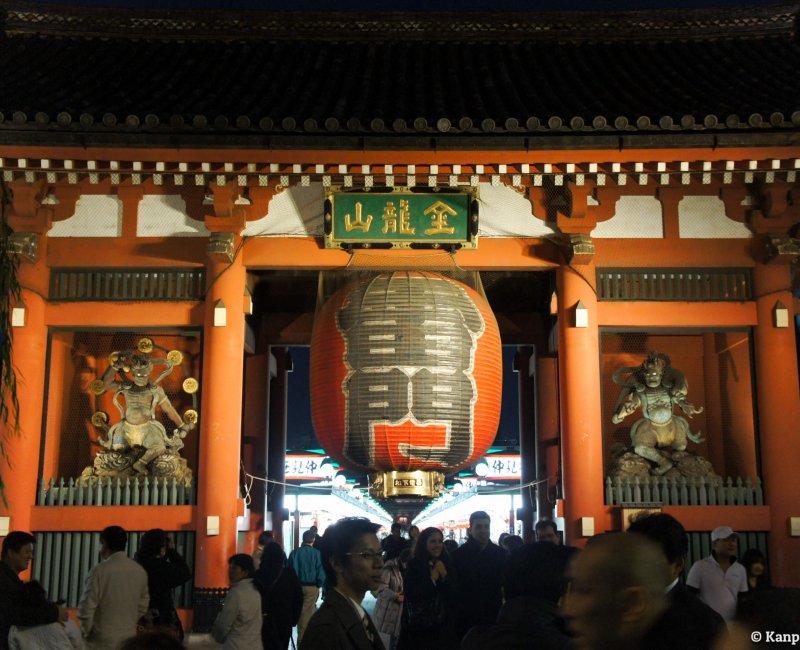
🐂 Tenjin (天神)
The sky deity and kami of calligraphy and literature, Tenjin is the deified name of the intellectual and statesman Sugawara no Michizane (845 - 903).
Historian, poet and professor of Chinese literature, this scholar was appointed Minister of the Right in 899 by the Emperor of Japan. Thus began the rivalry with the powerful Fujiwara clan, who were holding the position of Minister of the Left and refused to share the power with a scholar born in a lower class.
Wrongfully accused of plotting against the imperial power, he was exiled on Kyushu Island and became governor of Dazaifu. After his death, several incidents, such as the premature death of the Fujiwara minister, as well as a fire at the palace induced people to think of the vengeance of Michizane’s spirit. In order to rehabilitate him officially, he was posthumously appointed Chancellor of the Realm and deified as kami Tenjin. Dazaifu Tenmangu shrine was therefore built in his honor so his soul can eternally rest in peace.
The god of studies for the younger ones, Tenjin is now prayed by many pupils and students for their academic success and before important exams. Its sacred messenger animal is the ox and worshippers pet the animal's statue for good luck.
The Emperor of Japan as direct descendant
The emperors of Japan – or Tenno – have long been considered as living incarnations of Shinto gods. The legendary first emperor Jinmu is, according to the official mythology, a direct descendant of the sun goddess Amaterasu. The reigning members afterwards were all born from the same lineage of exceptional blood, including the present days emperor Naruhito.
This divinization of the emperor and broadly of the Japanese people has led the country to some excesses, justifications, and invasions throughout its history, and especially during the World War II. Nowadays, the Emperor has lost his status of divinity but remains an important figure, symbol of the nation united and guarantor of the ancestral Shinto rituals.
Shinto also includes in its pantheon many other legendary creatures such as tengu 👺 or yokai appearing in the Japanese folklore, tales, and legends.

